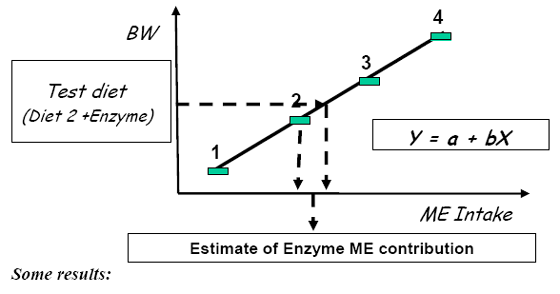



Enzyme Synergy in Poultry Nutrition
The effects of different feed enzymes may not be additive, Marcelo J. Schang of the School of Agricultural Sciences at Argentina's Catholic University told the 2008 Carolina Poultry Nutrition Conference.With other consequences, the recent worldwide economic crisis has demonstrated that the price of commodities – fuel and grains, mainly – are not necessarily associated with strict rules of supply and demand. At the time the stock markets were falling and with little evidence of reductions in livestock production (beef, dairy, poultry and pig were not altered), the commercial value of both corn and soya dropped to almost half of their previous prices. A similar situation showed oil prices returning in a few days to a value of around $85 per barrel.
These trends would clearly demonstrate that productivity in animal production can be easily modified by simple market speculations leaving to nutritionists few possibilities to control or predict grain prices. At the same time, this economic situation should serve to elevate the value of biological facts to a higher level particularly considering that irrespective of ingredient prices, feed cost represents between 50 to 70 per cent of the total cost of production. In this regard – and more than ever – the ability of nutritionists to take advantage of technologies associated with the improvements of feed digestibility may certainly result in reinforcements of the competitiveness of companies dedicated to animal production.
Corn-Soy Diets and Digestibility
The increase in world soya production and processing has made soybean meals more available for poultry and pig production. Consequently corn-soy diets became widely fed at the time of serving as reference feed in terms of nutrient composition and digestibility. However, it is known that while digestibility of energy in corn is relatively high – in general, over 90 per cent – in soya (both meal and full-fat) energy digestibility range is 70 to 75 per cent. This limitation in soya energy yield (and other plant protein sources) has been associated to the presence of anti-nutritional factors in the ingredient and to reduced enzyme activity at the animal level. Thus, the development of technologies orientated to improve nutrient (energy, protein, phosphorus) digestibility has been focused on by researchers and the economic importance has been recognised by private companies.
Contribution of Exogenous Enzymes
Independently of the variation in absolute results, it should be recognized that the possibility of using exogenous enzymes in non-ruminant diets has provided nutritionists with a very important tool to improve feed digestibility, to moderate environmental contamination and to reduce feed cost.
Based on experimental results, several commercial approaches have been suggested for enzyme utilization in pig and poultry feeds. While some single enzymes are proposed to promote single effects on a particular chemical component of the diet, some others combine several enzymes (naturally occurring or as a cocktail) in order to cope with more than one substrate. Independently of the approach, it is clear that enzymes are specific (maintain a given enzyme:substrate ratio) and are only effective when several conditions like temperature, humidity and pH are achieved. In other words, if similar enzymes are competing for a similar substrate, the action of those enzymes would not be additive.
There have not been defined standard procedures for evaluating the effects of exogenous enzymes in animal feeds. However the importance of some aspects have been recognised at this time to set up experiments: to have a negative control, to formulate experimental diets below the nutrient recommendations for maximum performance, to define clearly the objective of the trials (be it to improve performance or maintain performance at a lower cost) to define the use of the enzyme 'on top' of the diet or 'up lifting' nutrient allowances.
In general, the results obtained from these trials together with field data demonstrates the benefits provided by the use of exogenous enzymes when feeding pig and poultry, particularly from the economic point of view.
Single Action and Synergy of Exogenous Enzymes
Under certain economic conditions, nutritionists are tempted to incorporate in their diets more than one type of enzyme, assuming that independent enzyme effects may be additive. Unfortunately, there is almost no scientific information in this field and the competition for similar substrate may reduce the benefits provided by single enzymes.
Based on these observations, an experimental approach was defined to evaluate the improvements in energy yield due to enzyme (single or combined) utilisation in poultry diets. The trial consisted of feeding rations formulated to contain increasing levels of metabolisable energy (ME) to obtain a linear response in terms of body weight gain. The enzyme to be evaluated was added 'on-top' of one of the former diets (low in energy) in order to observe the effect on body weight gain. Any difference in performance between birds with this treatment (with enzyme) and those corresponding to the standard diet (no enzyme addition) would be due to the effect of enzyme addition. Regression analysis was performed and the procedure allows the estimation of the energy yield provided by the enzyme addition (Figure 1).

The procedure indicated above was applied in a couple of experiments to evaluate the effect of adding more than one enzyme to poultry diets.
In the first growing trial (at Universidad Central de Venezuela), three corn-soy diets were formulated to provide ME levels of 2,850, 2,950 and 3,050 kcal/kg (from 0 to 28 days of age) and 2,950, 3,050 and 3,150 kcal/kg (29 to 42 days). All diet formulations assumed a seven per cent up lifting in soybean meal ME, crude protein (CP) and amino acids (AA) due to the addition of a commercial enzyme. On top of a fourth diet (similar to diet 1; 2,850 kcal/kg), a second enzyme was added that was promoted to increase diet energy yield in 75 kcal/kg. The trial lasted 28 days and the result showed a linear response in body weight as intake of ME was increased. When plotting the data of treatment 4 in the corresponding equation, the estimate of ME yield due to the addition of the second enzyme was 56 kcal/kg of feed.
In a second 28-day trial (at Instituto Nacional de Tecnologia Agropecuaria, Argentina), a similar experimental approach was followed except that four corn-soy diets instead of three were formulated (2,750, 2,850, 2,950 and 3,050 kcal/kg). In this case, the calculated increase in diet ME due to a second enzyme addition was 52 kcal/kg.
As a result of the experiments, it was possible to conclude that the recommendation given for the second enzyme (75 kcal/kg) when used alone has to be reduced to around 60 kcal/kg when combined with the other enzyme.
Interpretation and Considerations
The results showed that the use of enzymes that are competing for the same substrate cannot be recommended by the simple addition of their single effects. In practical terms and due to lack of precision in identifying the action of the given enzymes, the effect of one of the enzymes should be fixed while the benefits of the other should be reduced. This assumption may impact on feed cost calculations, requiring the knowledge and experience of each nutritionist to decide the correct commercial enzyme recommendations.
As mentioned, and irrespective of the economic variations, feed cost represents the largest proportion of total production costs. In addition, present trends in corn use for ethanol production in developed countries and soya demands from emerging countries may have modified the actual map of meat producing countries. As a result, it could be valid to speculate that competitiveness of grain producing countries would be higher than those of grain importing countries. In all cases, however, the possible reduction in corn and soya supplies would negatively impact on digestibility of animal diets.
The proven technology associated with the use of enzymes (along or in combination) would certainly assist to economically increase feed digestibility in order to reach animal genetic potential.
Further Reading
| - | You can view other papers presented at the Carolina Poultry Nutrition Conference 2008 by clicking here. |
April 2009








